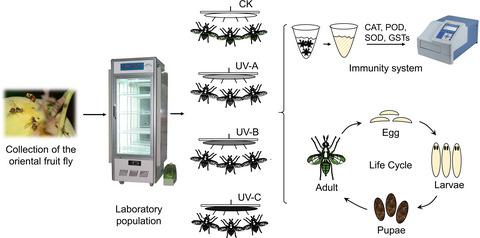当前位置:
X-MOL 学术
›
Food Energy Secur.
›
论文详情
Our official English website, www.x-mol.net, welcomes your
feedback! (Note: you will need to create a separate account there.)
UV radiation increases mortality and decreases the antioxidant activity in a tephritid fly
Food and Energy Security ( IF 4.0 ) Pub Date : 2021-05-25 , DOI: 10.1002/fes3.297 Hongying Cui 1 , Yiying Zeng 1 , Gadi V.P. Reddy 2 , Feng Gao 1 , Zhihong Li 1 , Zihua Zhao 1
Food and Energy Security ( IF 4.0 ) Pub Date : 2021-05-25 , DOI: 10.1002/fes3.297 Hongying Cui 1 , Yiying Zeng 1 , Gadi V.P. Reddy 2 , Feng Gao 1 , Zhihong Li 1 , Zihua Zhao 1
Affiliation

|
Ultraviolet (UV) radiation has been widely used to monitor insects and conduct surface sterilizations at 365 nm and 254 nm wavelengths, respectively. The global increase in the use of UV light has raised concerns about environmental impacts and effects on non-target organisms. We, therefore, examined the effects of three UV radiation wavelengths (365 nm, 308 nm and 254 nm) on the survival and antioxidant activities of a tephritid fruit fly, Bactrocera dorsalis. Exposure to UV radiation significantly increased B. dorsalis cohort mortality and the duration of pre-oviposition. Moreover, the application of UV-B and UV-C significantly decreased egg laying. The activities of antioxidant enzymes were irreversibly decreased by UV-A, UV-B and UV-C radiation. Decreases in catalase (CAT), superoxide dismutases (SOD) and glutathione-S-transferases (GST) activity were observed at both immediately after exposure and also at 120 h after exposure. However, while peroxidase (POD) activity was decreased immediately after UV-B and UV-C radiation, the activity had recovered at 120 h post-exposure. These results demonstrate UV-dependent decreases in the activities of antioxidant enzymes are associated with decreased B. dorsalis survival rates. While UV radiation can, therefore, be harmful to non-target organisms, it is a potential strategy for integrated pest management.
中文翻译:

紫外线辐射增加死亡率并降低实蝇的抗氧化活性
紫外线 (UV) 辐射已被广泛用于监测昆虫并分别在 365 nm 和 254 nm 波长下进行表面消毒。紫外线使用的全球增加引起了人们对环境影响和对非目标生物的影响的担忧。因此,我们研究了三种紫外线辐射波长(365 nm、308 nm 和 254 nm)对实蝇(Bactrocera dorsalis)存活和抗氧化活性的影响。暴露于UV辐射显著增加乙。 背肌队列死亡率和产卵前的持续时间。此外,UV-B 和 UV-C 的应用显着降低了产蛋率。UV-A、UV-B和UV-C辐射会不可逆地降低抗氧化酶的活性。在暴露后立即和暴露后 120 小时都观察到过氧化氢酶 (CAT)、超氧化物歧化酶 (SOD) 和谷胱甘肽-S-转移酶 (GST) 活性的降低。然而,虽然过氧化物酶 (POD) 活性在 UV-B 和 UV-C 辐射后立即降低,但活性在暴露后 120 小时恢复。这些结果表明抗氧化酶活性的紫外线依赖性降低与B降低有关。 背肌存活率。因此,虽然紫外线辐射可能对非目标生物有害,但它是综合虫害管理的潜在策略。
更新日期:2021-05-25
中文翻译:

紫外线辐射增加死亡率并降低实蝇的抗氧化活性
紫外线 (UV) 辐射已被广泛用于监测昆虫并分别在 365 nm 和 254 nm 波长下进行表面消毒。紫外线使用的全球增加引起了人们对环境影响和对非目标生物的影响的担忧。因此,我们研究了三种紫外线辐射波长(365 nm、308 nm 和 254 nm)对实蝇(Bactrocera dorsalis)存活和抗氧化活性的影响。暴露于UV辐射显著增加乙。 背肌队列死亡率和产卵前的持续时间。此外,UV-B 和 UV-C 的应用显着降低了产蛋率。UV-A、UV-B和UV-C辐射会不可逆地降低抗氧化酶的活性。在暴露后立即和暴露后 120 小时都观察到过氧化氢酶 (CAT)、超氧化物歧化酶 (SOD) 和谷胱甘肽-S-转移酶 (GST) 活性的降低。然而,虽然过氧化物酶 (POD) 活性在 UV-B 和 UV-C 辐射后立即降低,但活性在暴露后 120 小时恢复。这些结果表明抗氧化酶活性的紫外线依赖性降低与B降低有关。 背肌存活率。因此,虽然紫外线辐射可能对非目标生物有害,但它是综合虫害管理的潜在策略。









































 京公网安备 11010802027423号
京公网安备 11010802027423号